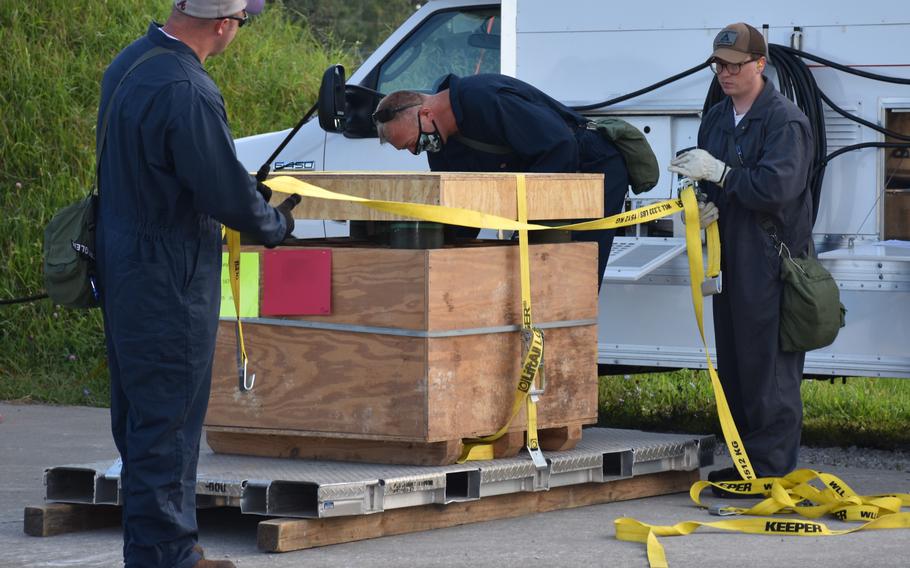
Blue Grass Chemical Activity personnel strap the last of the mustard overpacked projectiles onto a tray for loading into an enhanced on-site container. (Jana Felts/U.S. Army)
BLUE GRASS ARMY DEPOT, Ky. (Tribune News Service) — The last 155mm projectiles containing mustard agent were destroyed in the Static Detonation Chamber at the Blue Grass Chemical Agent-Destruction Pilot Plant (BGCAPP) Sept. 4 according to a press release.
This marks the third of five chemical weapons destruction campaigns completed at the Blue Grass Army Depot (BGAD).
"There is no doubt destroying the mustard projectiles in a Static Detonation Chamber was the right choice of technology to use," said Dr. Candace Coyle, BGCAPP site project manager, in the release. "We knew the 1940s-era mustard agent would prove difficult to destroy due to its age and impurities."
"The safety performance of our team was outstanding throughout the entire campaign," said Ron Hink, Bechtel Parsons Blue Grass (BPBG) project manager. "Our team faced numerous challenges with the destruction of the mustard projectiles, but we were able to overcome those challenges and safely and successfully complete their destruction."
A 2011 X-ray assessment of the chemical weapons stockpile in Kentucky confirmed the solidification of agent in a significant number of mustard projectiles, rendering them unsuitable for automated processing in the main plant, as originally planned. These problematic munitions required a different technological approach for their destruction. The BGCAPP team worked closely with oversight officials and community members to select the Static Detonation Chamber to destroy the mustard stockpile.
"This marks another milestone in the overall disposal effort, making three of the five campaigns successfully completed," said Craig Williams, Chemical Destruction Community Advisory Board co-chair. "This achievement reflects what can be accomplished when the government, the contractors and the community work cooperatively towards a common objective. The workforce operating through the pandemic was a truly heroic effort."
The destruction of 155mm projectiles containing mustard agent was the first campaign to begin in Kentucky on June 7, 2019. Since that time, workers safely processed more than 15,000 projectiles in the Static Detonation Chamber.
The chamber used a thermal destruction technology to destroy the weapons. Munitions were fed into the electrically heated chamber. The high heat (approximately 600 degrees Celsius or 1,100 degrees Fahrenheit) deflagrated or detonated the munitions, and the chemical agents and energetics were destroyed by thermal decomposition. Gases generated as a result of the deflagration were treated by an off-gas treatment system that included a thermal oxidizer, scrubbers and a carbon filter system. Scrap metal was decontaminated for recycling.
Throughout the campaign, the BGCAPP team worked closely with BGAD and Blue Grass Chemical Activity (BGCA) partners to destroy the chemical weapons.
"I greatly appreciate the professionalism and attention to detail consistently demonstrated by the BGCAPP and BGCA team," said Col. Steve Dorris, BGAD commander. "Safe operations and remaining good stewards of the environment are paramount to successful mission accomplishment. The BGCAPP and BGCA team both value their depot and community partnerships in thought, word and deed."
"The work being done by our partners at BGCAPP to destroy the nation's remaining chemical weapons stockpile is exceptional," said Lt. Col. Ed Williams, BGCA commander. "I am proud of the support that BGCA has provided to the mustard projectile campaign and the great work being accomplished. I extend my congratulations to the folks at BGCAPP for reaching another demilitarization milestone."
The chemical weapons stockpile at the depot originally consisted of 523 tons of chemical agent configured in 155mm projectiles containing mustard and VX nerve agent, 8-inch projectiles containing GB nerve agent, and M55 rockets containing GB and VX nerve agent.
As of Aug. 27, more than 163 tons, or 31.2% of the original stockpile of chemical agent has been destroyed in Kentucky.
From January through May 2020, nearly 4,000 8-inch projectiles containing GB nerve agent were destroyed at BGCAPP. From January through May 2021, nearly 13,000 155mm projectiles containing VX nerve agent were destroyed at BGCAPP. The completion of the mustard campaign marks the destruction of all projectiles in Kentucky, leaving only rockets to destroy. Currently, M55 rockets containing VX nerve agent are being destroyed in the main plant. The main plant uses a neutralization technology to destroy the nerve agent portion of the stockpile.
The Program Executive Office, Assembled Chemical Weapons Alternatives is responsible for destruction of the remaining U.S. chemical weapons stockpile in Colorado and Kentucky. The organization oversees the contract for design, construction, systemization, operation and closure of BGCAPP with BPBG and subcontractors Amentum, Battelle Memorial Institute and GP Strategies.
The stockpile sites in Colorado and Kentucky account for the last 10% of what was originally a national stockpile of more than 30,000 tons of chemical weapons. The U.S. Army Chemical Materials Activity destroyed the initial 90%, which was stored at seven other sites across the U.S. and Johnston Atoll in the Pacific. Chemical weapons destruction in Colorado began in 2015. Both sites are on target to complete destruction of chemical weapons by 2023.
(c)2021 the Richmond Register (Richmond, Ky.)
Visit the Richmond Register (Richmond, Ky.) at richmondregister.com
Distributed by Tribune Content Agency, LLC.